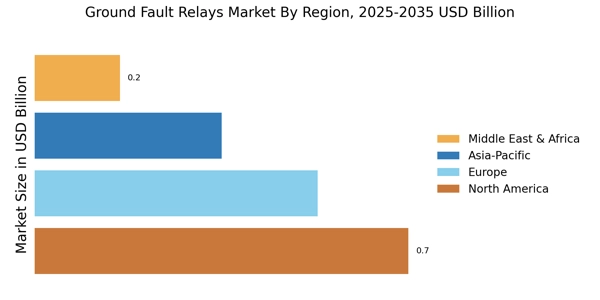Regulatory Compliance and Standards
The Ground Fault Relays Market is significantly influenced by stringent regulatory compliance and safety standards. Various international and regional regulations mandate the use of ground fault protection in electrical installations, particularly in commercial and industrial sectors. Compliance with these regulations is essential for ensuring safety and preventing electrical accidents. As a result, manufacturers are increasingly focusing on developing relays that meet or exceed these standards. The market data suggests that regions with stricter regulations are witnessing higher adoption rates of ground fault relays. This regulatory landscape not only drives demand but also encourages innovation in the Ground Fault Relays Market, as companies strive to create products that align with evolving safety requirements.
Expansion of Renewable Energy Sources
The Ground Fault Relays Market is poised for growth due to the expansion of renewable energy sources, such as solar and wind power. As these energy systems become more prevalent, the need for effective protection mechanisms against ground faults is increasingly recognized. Ground fault relays play a critical role in safeguarding renewable energy installations, ensuring operational reliability and safety. The integration of these relays in solar inverters and wind turbine systems is becoming standard practice. Market data suggests that the renewable energy sector is expected to grow substantially, which will likely drive demand for ground fault relays. This trend underscores the importance of adapting safety solutions to meet the unique challenges posed by renewable energy technologies within the Ground Fault Relays Market.
Growing Awareness of Electrical Safety
The Ground Fault Relays Market is benefiting from a heightened awareness of electrical safety among consumers and businesses alike. As incidents of electrical hazards continue to pose risks, there is a growing emphasis on implementing safety measures, including the installation of ground fault relays. Educational campaigns and training programs are increasingly promoting the importance of electrical safety, leading to a surge in demand for reliable protection devices. Market data indicates that sectors such as construction and manufacturing are particularly focused on enhancing safety protocols, thereby driving the adoption of ground fault relays. This trend reflects a broader societal shift towards prioritizing safety, which is likely to sustain growth in the Ground Fault Relays Market.
Technological Advancements in Ground Fault Relays
The Ground Fault Relays Market is experiencing a notable transformation due to rapid technological advancements. Innovations in microprocessor-based relays are enhancing the accuracy and reliability of fault detection. These advanced systems are capable of providing real-time monitoring and diagnostics, which is crucial for preventing electrical hazards. The integration of smart technologies, such as IoT and AI, is also becoming prevalent, allowing for predictive maintenance and improved operational efficiency. According to recent data, the market for smart relays is projected to grow significantly, indicating a shift towards more sophisticated solutions in the Ground Fault Relays Market. This trend not only enhances safety but also reduces downtime and maintenance costs, making it a compelling driver for market growth.
Increased Investment in Infrastructure Development
The Ground Fault Relays Market is experiencing a boost from increased investment in infrastructure development across various sectors. Governments and private entities are allocating substantial resources towards upgrading electrical systems in buildings, transportation, and industrial facilities. This investment often includes the installation of advanced safety devices, such as ground fault relays, to enhance electrical safety and reliability. Market data indicates that regions undergoing significant infrastructure projects are seeing a corresponding rise in the demand for ground fault protection solutions. This trend not only reflects a commitment to safety but also highlights the critical role of ground fault relays in modern electrical systems. As infrastructure development continues, the Ground Fault Relays Market is likely to benefit from sustained demand.


















Leave a Comment